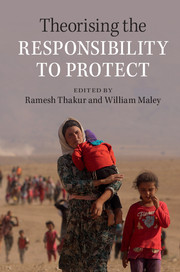Book contents
- Frontmatter
- Contents
- List of figures
- Notes on contributors
- Part I Context
- 1 Introduction: theorising global responsibilities
- 2 The evolution of the Responsibility to Protect: from concept and principle to actionable norm
- 3 From the right to persecute to the Responsibility to Protect: Feuerbachian inversions of rights and responsibilities in state–citizen relations
- 4 The Responsibility to Protect and a theory of norm circulation
- Part II The Responsibility to Protect, normative theory and global governance
- Part III The Responsibility to Protect and international social purposes
- Index
3 - From the right to persecute to the Responsibility to Protect: Feuerbachian inversions of rights and responsibilities in state–citizen relations
from Part I - Context
Published online by Cambridge University Press: 05 August 2015
- Frontmatter
- Contents
- List of figures
- Notes on contributors
- Part I Context
- 1 Introduction: theorising global responsibilities
- 2 The evolution of the Responsibility to Protect: from concept and principle to actionable norm
- 3 From the right to persecute to the Responsibility to Protect: Feuerbachian inversions of rights and responsibilities in state–citizen relations
- 4 The Responsibility to Protect and a theory of norm circulation
- Part II The Responsibility to Protect, normative theory and global governance
- Part III The Responsibility to Protect and international social purposes
- Index
Summary
The Responsibility to Protect, commonly shortened to R2P, is widely seen as a quintessentially post-Westphalian, liberal, internationalist norm. As such, it is alternately the poster-boy and whipping-boy of the supporters and detractors of liberal internationalism. However, its relationship with Westphalian statehood is a little more complex. R2P owes it origins to a major push by UN Secretary-General Kofi Annan, scarred by the atrocities in Rwanda in 1994 and Srebrenica in 1995 that happened on his watch as the under-secretary-general for peacekeeping, to forge a new normative consensus on when and how the international community should prevent and stop such tragedies. In his first report on R2P in 2009, his successor, Ban Ki-moon, reframed R2P in the metaphor of three pillars. Pillar One was defined as ‘the enduring responsibility of the State to protect its populations, whether nationals or not, from genocide, war crimes, ethnic cleansing and crimes against humanity, and from their incitement’. Pillar Two was described as ‘the commitment of the international community to assist States in meeting those obligations’. Pillar Three was defined as ‘the responsibility of Member States to respond collectively in a timely and decisive manner when a State is manifestly failing to provide … protection’. While primacy was to be given to peaceful means, should they prove inadequate to ensure protection, the international community should use more robust action: ‘no strategy for fulfilling the responsibility to protect would be complete without the possibility of collective enforcement measures, including through sanctions or coercive military action in extreme cases’.
The first pillar of R2P thus provides the core justification for sovereigns claims to rule and the basis of the social contract that Hobbes posited for their subjects. However, the security of their subjects was doubly undermined: first by the fraudulent nature of the claims of many sovereigns to protect their subjects, and secondly because the successful repression of civilians was one of the most common ways of establishing sovereignty and the basis of sovereign legitimacy. Seventeenth-century ‘R2P’ was more likely to be the ‘right to persecute’ than a responsibility to protect.
The Enlightenment turned the relationship between sovereign and subject on its head in an inversion that Sampford has likened to Feurbach's suggested reversal of the relationship between man and God.
- Type
- Chapter
- Information
- Theorising the Responsibility to Protect , pp. 38 - 58Publisher: Cambridge University PressPrint publication year: 2015
- 5
- Cited by

